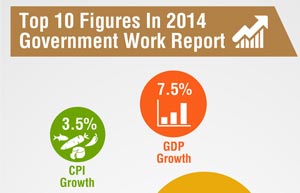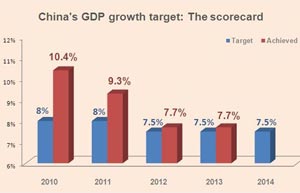More confidence needed in Chinese economy: overseas media
(Xinhua) Updated: 2014-03-14 11:32BEIJING - Concern has resurfaced in recent months that data pointing to softening Chinese manufacturing activity indicate the world's second largest economy may be headed for a hard-landing.
However, the 7.5 percent growth target set by the Chinese government for 2014 helped stabilize market expectations, especially on overseas markets, foreign media reported.
French newspaper Le Figaro said it was reassuring to the international community that a major engine of the global economy maintained steady growth.
Cora Jungbluth, a project manager at Bertelsmann Foundation, said a growth rate of 7.5 percent was still quite an aggressive target, considering the global and domestic economic situation.
"We set a proper range for China's economic operation, and that is to say, we worked to ensure that GDP growth and employment would not slide below the lower limit, and inflation would not exceed the upper limit," Chinese Premier Li Keqiang told a press conference Thursday after the annual parliamentary session ended.
However, as some analysts pointed out, a booming world economy not only requires steady growth in China, but also the cooperation of other countries.
The structural problems facing the emerging economies should not be exploited by the developed ones as excuses to offload their responsibilities in reform, and it is unfair to expect the emerging economies to over-exert themselves in order to drive the world, according to some analysts.
Li Guangrong, chairman of Tehua Investment Holding Co Ltd, said the remodeling of the world needed the efforts of different countries, as well as an international relations and regulation system focused on collaboration and mutual benefit.
Yet, China indeed faces deep-rooted structural imbalances, and the factors that might lead to a structural slowdown are emerging. The question as to how to manage the risks while retaining the growth momentum has become the concern of overseas media.
A comment piece published in English newspaper The Financial Times said China eventually would re-balance its economy and turn to a more sustainable mode. The sooner the transformation started, the smaller the risks would be in the process, it said.
Justin Yifu Lin, economist and former chief economist and senior vice president of the World Bank, in an article on the Financial Times' Chinese website, wrote it was not unexpected China's economy was slowing. Compared to other countries, China had performed better when exposed to the same external shock.
The Chinese economy enjoyed a late-developing advantage, by which China could transform its potential to solid growth through persistent technological innovation and industry upgrade, Lin said.
In Li's government work report earlier this month, he mentioned using innovation to support and lead economic structural improvement and upgrading, pushing China's industry to a higher position in the global value chain. As the structural adjustment continues, the domestic demand it releases will bring more opportunity to the world and provide more benefit.
As some foreign scholars pointed out, the international community should learn to tale a more positive and sensible view of the Chinese economy. What China and the rest of the world are engaging in is not a zero-sum game, but a win-win situation.
Pessimistic views of the Chinese economy is a misreading and misjudgment of the country's economic situation and of no help to the global market and economy.
|
 |
 |
- NHTSA says finds no 'defect trend' in Tesla Model S sedans
- WTO rare earth ruling is unfair
- Amway says 2014 China sales may grow 8%
- President Xi in Europe: Forging deals, boosting business
- CNOOC releases 2013 sustainability report
- Local production by Chery Jaguar Land Rover this year
- Car lovers test their need for speed in BMW Mission 3
- China stocks close mixed Monday

















